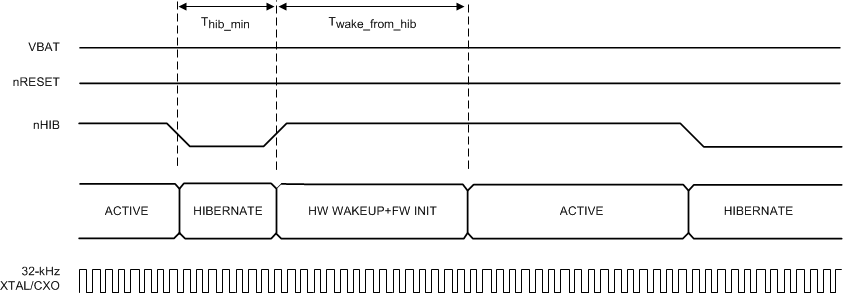ZHCSK48D February 2019 – May 2021 CC3135MOD
PRODUCTION DATA
- 1 特性
- 2 应用
- 3 说明
- 4 功能方框图
- 5 Revision History
- 6 Device Comparison
- 7 Terminal Configuration and Functions
-
8 Specifications
- 8.1 Absolute Maximum Ratings
- 8.2 ESD Ratings
- 8.3 Recommended Operating Conditions
- 8.4 Current Consumption Summary: 2.4 GHz RF Band
- 8.5 Current Consumption Summary: 5 GHz RF Band
- 8.6 TX Power Control for 2.4 GHz Band
- 8.7 TX Power Control for 5 GHz Band
- 8.8 Brownout and Blackout Conditions
- 8.9 Electrical Characteristics for DIO Pins
- 8.10 WLAN Receiver Characteristics
- 8.11 WLAN Transmitter Characteristics
- 8.12 BLE and WLAN Coexistence Requirements
- 8.13 Reset Requirement
- 8.14 Thermal Resistance Characteristics for MOB Package
- 8.15 Timing and Switching Characteristics
- 8.16 External Interfaces
- 9 Detailed Description
- 10Applications, Implementation, and Layout
- 11Environmental Requirements and SMT Specifications
- 12Device and Documentation Support
- 13Mechanical, Packaging, and Orderable Information
8.15.4 Wakeup From HIBERNATE Mode Timing
Figure 8-7 shows the timing diagram for wakeup from HIBERNATE mode.
 Figure 8-7 nHIB Timing Diagram
Figure 8-7 nHIB Timing DiagramNote:
The internal 32.768-kHz XTAL is kept enabled by default when the chip goes into HIBERNATE mode in response to nHIB being pulled low.
Table 8-8 describes the timing requirements for nHIB.
Table 8-8 nHIB Timing Requirements
| ITEM | NAME | DESCRIPTION | MIN | TYP | MAX | UNIT |
|---|---|---|---|---|---|---|
| Thib_min | Minimum hibernate time | Minimum pulse width of nHIB being low(1) | 10 | ms | ||
| Twake_from_hib | Hardware wakeup time plus firmware initialization time | See(2) | 50 | ms |
(1) If temperature changes by more than 20°C, initialization time from HIB can increase by 200 ms due to radio calibration.
(2) Ensure that the nHIB pulse width is kept above the minimum requirement under all conditions (such as power up, MCU reset, and so on).